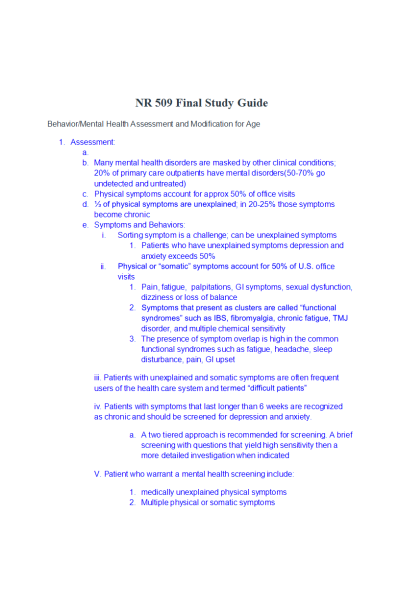Behavior/Mental Health Assessment and Modification for Age
- Assessment:
- Many mental health disorders are masked by other clinical conditions; 20% of primary care outpatients have mental disorders(50-70% go undetected and untreated)
- Physical symptoms account for approx 50% of office visits
- ⅓ of physical symptoms are unexplained; in 20-25% those symptoms become chronic
- Symptoms and Behaviors:
- Sorting symptom is a challenge; can be unexplained symptoms
- Patients who have unexplained symptoms depression and anxiety exceeds 50%
- Physical or “somatic” symptoms account for 50% of U.S. office visits
- Pain, fatigue, palpitations, GI symptoms, sexual dysfunction, dizziness or loss of balance
- Symptoms that present as clusters are called “functional syndromes” such as IBS, fibromyalgia, chronic fatigue, TMJ disorder, and multiple chemical sensitivity
- The presence of symptom overlap is high in the common functional syndromes such as fatigue, headache, sleep disturbance, pain, GI upset
- Sorting symptom is a challenge; can be unexplained symptoms
iii. Patients with unexplained and somatic symptoms are often frequent users of the health care system and termed “difficult patients”
iv. Patients with symptoms that last longer than 6 weeks are recognized as chronic and should be screened for depression and anxiety.
- A two tiered approach is recommended for screening. A brief screening with questions that yield high sensitivity then a more detailed investigation when indicated
V. Patient who warrant a mental health screening include:
- medically unexplained physical symptoms
- Multiple physical or somatic symptoms
- High severity of the presenting somatic symptom
- Chronic pain
- Symptoms longer than 6 weeks
- Physician stating “a difficult encounter”
- Recent stress
- Low self-rating of overall health
- Frequent use of health care services
- Substance abuse ..........................document continue
| Instituition / Term | |
| Term | Spring 2020 |
| Institution | Chamberlain |
| Contributor | Lydia |


















